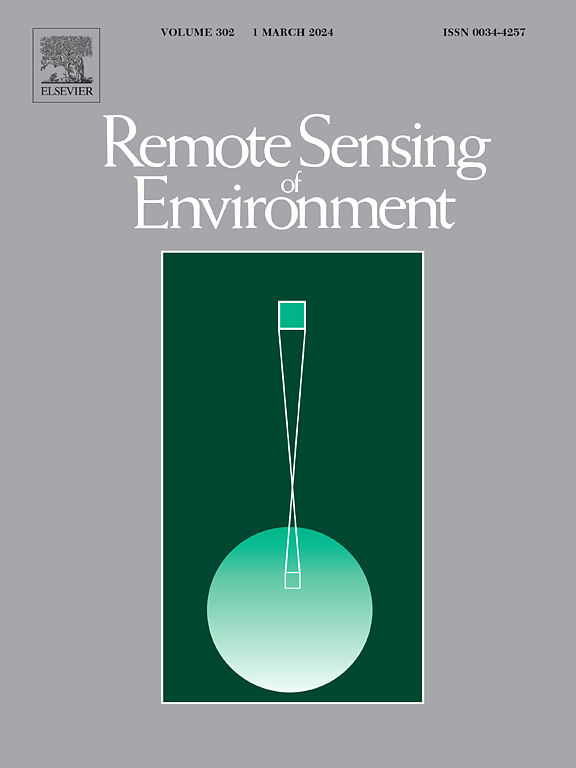A novel adaptive similarity-based ecological niche model for the endangered Yunnan snub-nosed monkey (Rhinopithecus bieti) using UAV LiDAR data
IF 11.1
1区 地球科学
Q1 ENVIRONMENTAL SCIENCES
引用次数: 0
Abstract
Ecological niche models (ENMs) are crucial for identifying habitat distribution patterns, understanding habitat preferences, and formulating effective conservation policies. However, accurately quantifying the three-dimensional (3D) structure of habitats, a fundamental component, presents challenges. These estimations heavily depend on the quality of original samples (presence/absence), yet reliable absence data requires prolonged and repeated observations, limiting both efficiency and accuracy. In the study, we focused on the endangered Yunnan snub-nosed monkey (Rhinopithecus bieti), listed on the International Union for Conservation of Nature (IUCN) Red List. We developed an adaptive similarity-based model that introduced a “similarity” pseudo-absence sampling approach for ecological niche modeling using fine-scale (20 m) 3D environmental variables from UAV LiDAR data. This approach integrated geographic similarity with an adaptive kernel density estimation (AKDE) method to prioritize pseudo-absence data sampling and then employed three typical machine learning models (SVM, BRT, and RF) for prediction, verifying the feasibility of this approach and offering direct insights into habitat distribution and preferences. The results indicated that the AKDE method provided the best fit in measuring similarity features. Through the model, the performance of estimations exhibited improved (AUC = 0.89–0.94, TSS = 0.71–0.82, and COR = 0.69–0.79), with average increases of 7 %, 14 %, and 12 %, respectively. The RF model produced more coherent suitable habitats, identifying regions at higher elevations (3100 m–3300 m) with preferences for low understory vegetation density (2–5 m, <10 %), moderate canopy relief ratio (> 0.35), lower tree height (10 m–25 m), and sunny slopes (0.60–1). Our findings demonstrate that integrating UAV LiDAR data with ecological niche modeling, along with the improved pseudo-absence sampling approach, enhances habitat assessment and offers significant potential for advancing conservation strategies.
基于无人机激光雷达数据的濒危物种云南金丝猴自适应相似度生态位模型
生态位模型对于识别生境分布格局、了解生境偏好和制定有效的保护政策具有重要意义。然而,准确量化栖息地的三维结构这一基本组成部分面临着挑战。这些估计在很大程度上依赖于原始样本的质量(存在/不存在),然而可靠的不存在数据需要长时间和重复的观察,这限制了效率和准确性。本研究以国际自然保护联盟(IUCN)濒危物种云南金丝猴(Rhinopithecus bieti)为研究对象。我们开发了一种基于自适应相似度的模型,该模型使用无人机激光雷达数据中的精细尺度(20米)三维环境变量,引入了一种“相似度”伪缺失采样方法,用于生态位建模。该方法将地理相似度与自适应核密度估计(AKDE)方法相结合,优先考虑伪缺失数据采样,然后采用三种典型的机器学习模型(SVM、BRT和RF)进行预测,验证了该方法的可行性,并提供了对栖息地分布和偏好的直接洞察。结果表明,AKDE方法在相似性特征测量中具有最佳的拟合性。通过该模型,估计的性能得到了改善(AUC = 0.89-0.94, TSS = 0.71-0.82, COR = 0.69-0.79),平均分别提高了7%,14%和12%。RF模型产生了更一致的适宜生境,确定了高海拔地区(3100 m - 3300 m)的低林下植被密度(2-5 m, < 10%),中等冠层起伏比(> 10%)的偏好。0.35),树高较低(10 - 25米),阳坡(0.60-1)。我们的研究结果表明,将无人机激光雷达数据与生态位建模相结合,以及改进的伪缺失采样方法,可以增强栖息地评估,并为推进保护策略提供重大潜力。
本文章由计算机程序翻译,如有差异,请以英文原文为准。
求助全文
约1分钟内获得全文
求助全文
来源期刊

Remote Sensing of Environment
环境科学-成像科学与照相技术
CiteScore
25.10
自引率
8.90%
发文量
455
审稿时长
53 days
期刊介绍:
Remote Sensing of Environment (RSE) serves the Earth observation community by disseminating results on the theory, science, applications, and technology that contribute to advancing the field of remote sensing. With a thoroughly interdisciplinary approach, RSE encompasses terrestrial, oceanic, and atmospheric sensing.
The journal emphasizes biophysical and quantitative approaches to remote sensing at local to global scales, covering a diverse range of applications and techniques.
RSE serves as a vital platform for the exchange of knowledge and advancements in the dynamic field of remote sensing.
 求助内容:
求助内容: 应助结果提醒方式:
应助结果提醒方式:


